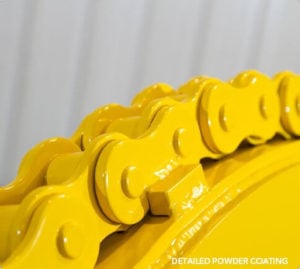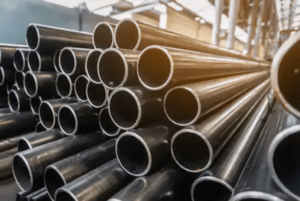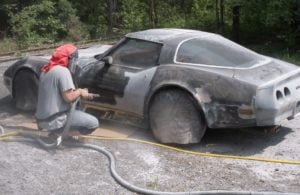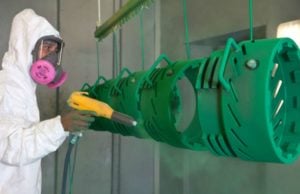Powder coating is an advanced method of applying finishes to metal for either protective or decorative reasons. It provides durable finishes in a wide range of color options and is considered to be a better alternative than traditional liquid paint coats.
Here are ten advantages and disadvantages of using powder coating:
Pros
1. Strong coating
Powder coating provides a durable finish that’s far stronger than what liquid paints offer. These coats are known to protect equipment in the harshest environments without compromising on the aesthetics of the finish. As a result, it’s common to find such coating used on large industrial equipment, structures, and oil field supplies. View our gallery to view our powerful coating work for a diverse range of customers.
2. Affordable
Powder coating is also affordable with the application process eliminating many extra steps and drying time that comes with liquid paint. The raw material powder is less expensive than wet paint and can be stored away in far less space than what traditional paint cans would need.
3. Various colors and finishes
Powder coating offers many colors and finishes. One can also easily have custom colors made by the manufacturer quickly, and there is a broad range of finishes from high gloss to matte. It’s even possible to customize the texture of the coat (e.g., texture or metallic).
4. Low maintenance
Powder coatings require little maintenance after application. Since the coating his highly durable and resistant to corrosion or scratches – there’s never a pressing need to use cleaning solutions or solvents to keep the surface in tip-top shape. Generally, you can expect to clean the applied coating only a few times a year.
5. Quick application
Powder coating is applied using an electromagnetic charge. This means there’s no need to wait for the coat to dry before applying another layer while applying the coating. It can all be done in one go with very little waste creation.
6. Even application
The application of powder coating also results in an even finished horizontal and vertical surface. This is due to the process of spraying and rapid heating to apply the powder coating. With liquid paint, you would run the risk of drips forming.
7. No toxic fumes
Liquid paints are known to release toxic fumes from volatile organic compounds into the air. With powder coatings, this risk is non-existent or very little, making it a far safer option to use.
8. Low carbon footprint
Powder coatings are also known to have a low carbon footprint throughout their value chain. This is great for businesses aiming to switch to more environmentally sustainable materials in their manufacturing process.
9. Recycle friendly
Liquid paints commonly create unwanted waste that needs to be disposed of properly. Powder coatings, however, can be recycled and reused. This makes them a more environmentally friendly, cost-effective, and efficient coating to use.
10. Greater transfer efficiency
While liquid paint coats have a transfer efficiency of 30% and nearly half of the product evaporates away. With powder coating, you get a 65% transfer efficiency on average, with any overspray recovered to be used again in the future as needed.
Cons
1. Can deteriorate from UV light – Depending on the powder chosen
As with any coating, over time, there will be gradual fading. Powder coatings are known to react strongest to UV light and contribute most to its fading. However, there are additional UV protective coats that can be applied to mitigate this.
Related: Find the Right Powder for You
2. Huge start-up cost
The application of powder coating can have high start-up costs. An electrostatic booth and oven are required to apply powder coating. Both of these are expensive to acquire and the cost to keep an oven running can be high. This makes it a less common coating option for low volume or small projects, not to mention for getting ISO certified and PCI certified.
3. Difficult to do thin coats
When looking to apply extremely thin coatings, powder coating may not be the best choice. The thinnest coating that can be applied without seeing a drop-in quality is 40 to 60 microns. For anything thinner than this, it’s advisable to use liquid paint instead for a better finish.
With ABITL’s new “MIL GAUGE GUN” we can take real-time measurement to apply the perfect amount of powder every time.
4. Slow color change vs Competitors
During the application process, color changes are common where machinery is cleaned of the previous coating color to be ready for a different one to applied. With powder coating, this can be a long process due to the greater risk of cross-contamination occurring if the machinery isn’t cleaned properly.
However, ABITL’s process is a state-of-the-art system that allows the cleaning process to be as fast as 5 to 7 minutes.
5. Powders can’t be mixed to make different colors
With liquid paint, it’s common practice to mix various paint colors to form new ones. With powder coating, this isn’t possible as the different polyester powders when mixed and applied won’t result in a new color forming. However, to combat this, there is a much wider range of powdered coating colors that one can buy. ABITL offers coating in a wide range of colors. Check out our powder suppliers to figure out which has the right one for you.
6. Specialized equipment needed to apply powder coating
Another disadvantage to powder coating is the need for specialized equipment such as electrostatic sprays. Moreover, the surface on which powder coating needs to be applied must be conductive. This creates limitations and can hinder how well the powdered coating reaches into deep recesses.
Since ABITL is a multi-million dollar facility with back up parts, the specialization of powder coating equipment does not pose a problem.
7. All coating needs to be baked in an oven
With powdered coating, there is no option but to use an oven for baking the powdered coating during the application process. It’s not possible to carry out an ambient cure. One minor problem is that the application process can be more expensive and longer.
8. Difficult touch-ups to execute
With liquid paints, it’s easy and convenient to perform minor touch-ups to any applied coating as needed. However, this powdered coating isn’t as easy and requires the entire process to be carried out.
Since ABITL has worked with many suppliers, diverse experience means an ability to touch up just about any coat.
9. Doesn’t work on a wide range of materials
As mentioned earlier, for the powdered coating to work, you need a conductive surface for the charged paint particles to attach to. As a result, the powdered coating is limited in the materials it can be applied to. Due to the use of an oven, one can’t apply powdered coating on materials that may melt such as rubber.
10. Less control over the process
The last disadvantage to powder coating is the lack of control over the application process. Compared to liquid paint coats, there’s less control over the smoothness of the coat and the amount of coating that can be applied.
With more than a dozen powder suppliers and their technicians we have control and can deliver a perfect coating every time.
ABITL are leaders in the powder coating process. With our own high-volume automated powder coating line, you can have high-quality coats applied in on-time and on-budget. With over 50 years of experience in powder coating, our Eighty-foot powder coating capacity can handle any volume of work sent our way.
Get in touch with us for your metal finishing needs today.






